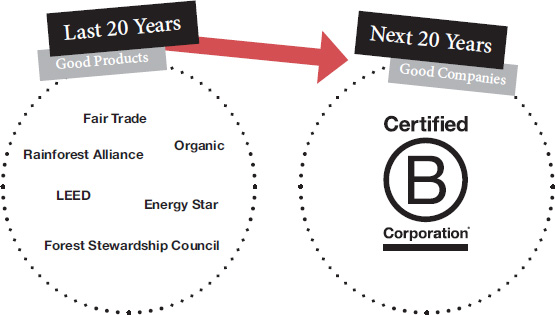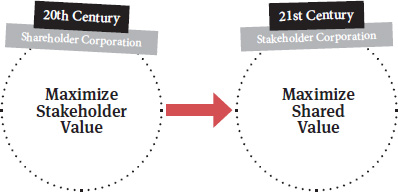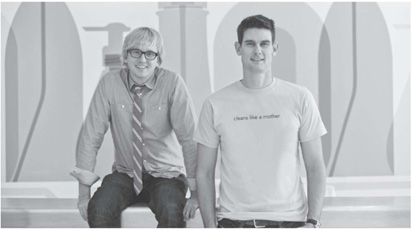
Download PDF Excerpt
Rights Information
The B Corp Handbook
How to Use Business as a Force for Good
Ryan Honeyman (Author) | Jay Gilbert (Foreword by) | Bart Houlahan (Foreword by) | Andrew Kassoy (Foreword by)
Publication date: 10/13/2014
Find out more about our Bulk Buyer Program
- 10-49: 20% discount
- 50-99: 35% discount
- 100-999: 38% discount
- 1000-1999: 40% discount
- 2000+ Contact Leslie Davis ( [email protected] )
1
Overview
Using Business as a Force for Good Is Good for Business
Before launching into the main content of this book, it is important to get one thing clear from the start: using business as a force for good is good for business. One of the most persuasive arguments for increasing your company’s social and environmental performance is that you will save money, enhance profitability, and generate more business value. If you or others in your company, such as the CEO, CFO, or an influential board member, are skeptical about anything that hints of “green” or “socially responsible,” then this section will give you a brief snapshot of the bottom-line, business case for sustainability.
Indeed, a veritable who’s who of thought leaders such as Accenture, Deloitte, Goldman Sachs, Harvard Business School, McKinsey & Company, and PricewaterhouseCoopers have released data-driven case studies, global surveys, and exhaustive reports that offer compelling proof that using business as a force for good is good for business.
For example, Goldman Sachs reported that “more capital is now focused on sustainable business models, and the market is rewarding leaders and new entrants in a way that could scarcely have been predicted even fifteen years ago.”1 Goldman Sachs found that there has been a dramatic increase in the number of investors seeking to incorporate sustainability and environmental, social, and governance factors into their portfolio construction.
In a report that echoes this sentiment, the International Finance Corporation found that the Dow Jones Sustainability Index performed an average of 36.1 percent better than the traditional Dow Jones Index over a period of five years.2 Comparable results have been found by some of the top academic institutions in the world. For example, a recent Harvard Business School study concluded that “high sustainability companies significantly outperform their counterparts over the long term, both in terms of stock market as well as accounting performance.”3
Accenture, in a global study of CEOs’ perspectives on sustainability, found that 93 percent of CEOs see sustainability as important to their company’s future success. Accenture reported that “demonstrating a visible and authentic commitment to sustainability is especially important … to regain and build trust from the public and other key stakeholders, such as consumers and governmentstrust that was shaken by the recent global financial crisis.”4
Although some claim that sustainability is a passing trend, Deloitte stated that “sustainability is a critical business issue that is quickly becoming a mandatory requirement.”5 Deloitte went on to argue that social and environmental responsibility will continue to be relevant because, unlike other business issues, sustainability is being shaped by constituencies such as shareholders, regulators, consumers and customers, nongovernment organizations, and other drivers outside of a company’s locus of control.
If you are on the fence, PricewaterhouseCoopers found a “positive, statistically significant, linear association between sustainability and corporate financial performance,”6 and McKinsey, in no uncertain terms, said, “The choice for companies today is not if, but how they should manage their sustainability activities.” McKinsey also reported that a fragmented, reactive approach to sustainability is no longer enough. “Companies can choose to see this agenda as a necessary evil—a matter of compliance or a risk to be managed while they get on with the business of business—or they can think of it as a novel way to open up new business opportunities while creating value for society.”7
Importantly, sustainability is not just about reducing your environmental footprint. Goldman Sachs notes that “research at both the corporate and university levels suggests that this next generation of employees and consumers have specific needs at work that are dramatically different from previous generations. High among these is a desire to align personal and corporate values. To attract and retain this group, we believe that companies need to provide rewards beyond financial gain.”8
A Brief History: From AND 1 to B Corps
I first discovered the AND 1 mixtapes in the late 1990s. The mixtapes were a series of basketball “streetballing” videos, created by the popular basketball shoe and apparel company AND 1, that featured lightning-quick ball handling, acrobatic slam dunks, and jaw-dropping displays of individual talent. I was a huge fan of the AND 1 mixtapes because the players used flashy, show-off moves that were very different from the more traditional style of basketball played in college or the NBA at the time. I was so fascinated with the mixtapes that I even integrated them into my lesson plans when I worked as an English teacher in Zhejiang Province, China.
Many years later, I was quite surprised to find out that two of AND 1’s cofounders, Jay Coen Gilbert and Bart Houlahan, along with Andrew Kassoy, their longtime friend and former Wall Street private equity investor, were the people who created the Certified B Corporation (also referred to as just B Corporation, or B Corp). I learned that Gilbert’s and Houlahan’s experiences at AND 1, and Kassoy’s on Wall Street, were central to their decision to get together to start B Lab, the nonprofit behind the B Corp movement.
AND 1 was a socially responsible business before the concept was well known, although AND 1 would not have identified with the term back then. AND 1’s shoes weren’t organic, local, or made from recycled tires, but the company had a basketball court at the office, on-site yoga classes, great parental leave benefits, and widely shared ownership of the company, and each year it gave 5 percent of its profits to local charities promoting high-quality urban education and youth leadership development. AND 1 also worked with its overseas factories to implement a best-in-class supplier code of conduct to ensure worker health and safety, fair wages, and professional development.
That was quite progressive for a basketball shoe company, especially because its target consumer was teenage basketball players, not conscious consumers with a large amount of disposable income. AND 1 was a company where an employee would be happy and proud to work.
AND 1 was also successful financially. From a bootstrapped start-up in 1993 to modest revenues of $4 million in 1995, the company grew to more than $250 million in U.S. revenues by 2001. This meant that AND 1—in less than ten years—had risen to become the number two basketball shoe brand in the United States (behind Nike). As with many endeavors, however, success brought its own set of challenges.
AND 1 had taken on external investors in 1999. At the same time, the retail footwear and clothing industry was consolidating, which put pressure on AND 1’s margins. To make matters worse, Nike decided to put AND 1 in its crosshairs at its annual global sales meeting, in order to gain a larger share of the market. Not surprisingly, this combination of external forces and some internal miscues led to a dip in sales and AND 1’s first-ever round of employee layoffs. After painfully getting the business back on track and considering their various options, Gilbert, Houlahan, and their partners decided to put the company up for sale in 2005.

HOW IT ALL STARTED. The seeds of the B Corp movement were planted at a basketball company called AND 1.
The results of the sale were immediate and difficult for Gilbert and Houlahan to watch. Although the partners went into the sale process with eyes wide open, it was still heartbreaking for them to see all of the company’s preexisting commitments to its employees, overseas workers, and local community stripped away within a few months of the sale.
The Search for “What’s Next?”
In their journey from basketball (and Wall Street) to B Corps, Gilbert, Houlahan, and Kassoy had a general sense of what they wanted to do next: the most good for as many people as possible for as long as possible. How this would manifest, however, was not initially clear.
Kassoy was increasingly inspired by his work with social entrepreneurs as a board member of Echoing Green (a venture capital firm focused on social change) and the Freelancers Insurance Company (a future Certified B Corporation). Houlahan became inspired to develop best practices to support values-driven businesses that were seeking to raise capital, grow, and hold onto their socially and environmentally responsible missions. And Gilbert, though proud of AND 1’s culture and practices, wanted to go much further, inspired by the stories of iconic socially responsible brands such as Ben & Jerry’s, Newman’s Own, and Patagonia, whose organizing principle seemed to be how to use business for good.
The three friends’ initial, instinctive answer to the “What’s next?” question was to create a new company. Although AND 1 had a lot to be proud of, they reasoned, the company hadn’t been started with a specific intention to benefit society. What if they started a company with that intention? After discussing different approaches, however, Gilbert, Houlahan, and Kassoy decided that they would be lucky to create a business as good as those created by existing social entrepreneurs such as Ahmed and Reem Rahim from Numi Organic Tea and Mike Hannigan and Sean Marx from Give Something Back Office Supplies. And more importantly, they decided that even if they could create such a business, one more business, no matter how big and effective, wouldn’t make a dent in addressing the world’s most pressing challenges.
They then thought about creating a social investment fund. Why build one company, they reasoned, when you could help build a dozen? That idea was also short lived. The three decided that even if they could be as effective as existing social venture funds such as Renewal Funds, RSF Social Finance, or SJF Ventures, a dozen fast-growing, innovative companies was still not adequate to address society’s challenges on a large scale.
What Gilbert, Houlahan, and Kassoy realized, after speaking with hundreds of entrepreneurs, investors, and thought leaders, was that there was a need for two basic pieces of infrastructure to accelerate the growth of—and amplify the voice of—the entire socially and environmentally responsible business sector. This existing community of leaders said they needed a legal framework to help them grow while maintaining their original mission and values, and credible standards to help them distinguish their businesses in a crowded marketplace, where everyone seemed to be making claims that they were a “good” company.
To that end, in 2006 Gilbert, Houlahan, and Kassoy cofounded B Lab, a nonprofit organization dedicated to harnessing the power of business to solve social and environmental problems. The B Lab team worked with many of these leading businesses, investors, and attorneys to create a comprehensive set of performance and legal requirements, and they started certifying the first B Corporations in 2007.
B Corps: The Quick and Dirty
Certified B Corporations are companies that have been certified by the nonprofit B Lab to have met rigorous standards of social and environmental performance, accountability, and transparency. B Corp certification is similar to LEED certification for green buildings, Fair Trade certification for coffee, or USDA Organic certification for milk. A key difference, however, is that B Corp certification evaluates an entire company (e.g., worker engagement, community involvement, environmental footprint, and governance structure) rather than looking at just one aspect of a company (e.g., the building or a product). This big picture evaluation is important because it helps distinguish between good companies and just good marketing.
Today, there is a growing, global community of more than 1,000 Certified B Corporations across dozens of industries working together toward one unifying goal: to redefine success in business so that one day all companies will compete not just to be the best in the world but also to be the best for the world.

A CERTIFICATION FOR THE ENTIRE COMPANY. B Corp certification helps consumers, investors, the media, and policy makers support organizations that are using business as a force for good.
Why B Corps Matter
Business is, for better or worse, one of the most powerful forces on the planet. At its best, business encourages collaboration, innovation, and mutual well-being, and helps people to live more vibrant and fulfilling lives. At its worst, business—and the tendency to focus on maximizing short-term profits—can lead to significant social and environmental damage, such as the BP Deepwater Horizon oil spill or the loss of more than $1 trillion in global wealth in the 2008 financial crisis.
Governments and nonprofits, moreover, are necessary yet insufficient to address society’s greatest challenges. Government budgets are already constrained and are likely to be more constrained in the future, and nonprofits, for all the great work that they do, are structurally limited in their ability to attract and retain talent, to rapidly grow to meet demand, and to adapt to new challenges, because they are heavily dependent on charitable funding.
Over the past thirty years, there has been a tremendous growth in the number of conscious consumers, socially responsible investments, and triple bottom line businesses that believe that business should strive to do no harm. More recently, there also has been a chorus of voices from thought leaders such as Sir Richard Branson, Thomas Friedman, Bill Gates, and Michael Porter, who have recognized a growing trend among entrepreneurs and business leaders toward creating market-based solutions to our most pressing global challenges.
How do B Corporations fit into this bigger context? What is the point? Why do B Corps matter? There are many reasons why B Corps matter, but the following are some of the reasons that are most meaningful to me and to the hundreds of B Corp representatives I spoke to during the writing of this book.
B Corps matter because they accelerate the evolution of capitalism. Many businesses tend to focus on short-term profits, not because these businesses are inherently greedy or evil but because short-term profits are the metric that is most often measured and rewarded. B Corporations believe that capitalism needs to evolve from a twentieth-century model that heavily emphasizes short-term profits for shareholders to a twenty-first-century model that creates shared and enduring prosperity for all stakeholders (including workers, suppliers, the community, the environment, and shareholders). B Corps accelerate this existing trend by creating, using, and promoting new legal structures that aim to create value for all stakeholders, as well as transparent, credible, comprehensive, and independent third-party standards of social and environmental performance that create a more efficient and effective marketplace.
THE EVOLUTION OF CAPITALISM. B Corporations are changing the default operating system of capitalism.
B Corps matter because they redefine success in business. B Corps create a new narrative, a new set of expectations, and a new focus on using the power of business for more than just profits. A great example of this is the work of Adam Lowry and Eric Ryan, the cofounders of Method. Lowry and Ryan took an uninspiring product category—soap—and built a movement around stylish, eco-friendly products that make cleaning safe and fun. Method’s products prevent triclosan, brominated vegetable oil, sodium lauryl sulfate, and other unpronounceable ingredients from getting into our homes and the environment. Method has built an imaginative, irreverent culture that allows its employees to express themselves through their work. It has generated great returns for its investors through its mission-aligned sale to Ecover, a European home products company, and now Ecover is considering whether to become a founding European Certified B Corporation. This is a laudable—perhaps heroic—achievement. And Lowry and Ryan are not alone. There are thousands of others like them, creating businesses that are high growth and high impact.
[B Corporations are] a powerful, no-cost, market-based solution to the systemic problem of “short-termism” and an innovative approach to using market forces to solve our most challenging problems.
Jack Markell, governor of Delaware
B Corps matter because they are concrete and measurable. B Corp certification turns the ambiguous concepts of “going green” or “being a good corporate citizen” into something tangible and measurable that people can easily identify, trust, and support. B Corps meet rigorous independent standards of performance for worker treatment, engage in their communities, and steward our environment. Most importantly, these standards—and information about how other B Corps perform against them—are transparent. This can help your business stand out in a crowded market, attract the best talent, and turn your customers into evangelists.
MAKING MONEY AND A DIFFERENCE. Method’s cofounders, Adam Lowry and Eric Ryan, have created a business that is both highly profitable and highly beneficial for society and the environment.
B Corps matter because they build collective voice. Many movements—from clean tech, microfinance, and sustainable agriculture to the Buy Local and co-op movements—are manifestations of the same idea: how to use business for good. The B Corporation amplifies the voice of this diverse marketplace behind the power of a unifying brand that stands for a better way to do business. Certified B Corporations include more than a thousand businesses, from more than sixty industries and thirty countries, that can speak with one voice when they collectively invite their thirty million closest family, friends, and followers to join them in celebrating the use of business as a force for good.
B Corp certification helps raise awareness around what is being done well in Afghanistan. It sets an example that an Afghan company can achieve international standards for ethical operations and transparency. It also benefits other Afghan companies by opening up more mentoring opportunities and demonstrating the path to apply for B Corp certification.
Luisa Walmsley, Corporate Social Responsibility Program Manager, Roshan
TELECOMMUNICATIONS—AFGHANISTAN
B Corps matter because they are better businesses. Many business owners have told me that B Corp certification has helped them become a better business on many different levels—from attracting talent, to raising capital, to winning new business. Indeed, Certified B Corporations were 63 percent more likely to survive the Great Recession (2007-2009) than the average U.S. small business. And when B Corps survive, they benefit all of their stakeholders by creating social, environmental, and financial value.
B Corps matter because they help us live to a higher purpose. There’s a reason why Rick Warren’s The Purpose-Driven Life is among the best-selling books of all time.9 Most people are motivated by a higher purpose, not profit. A Huffington Post blog by B Lab cofounder Gilbert summed up how B Corps tap into this energy: “Whether by law or custom, we believe and act as though business can have no purpose other than the maximization of profits. This belief … constrains our imagination and ability to live to our full potential as human beings. A full life is a life of service to something more than oneself, whether that something be family, friends, community, the environment, society, or future generations.”10
B Corps matter because they stand for something, not against anything. The B Corp movement stands for positive, innovative, and practical solutions to global problems. There are no furious tirades about politicians or corporate greed. Indeed, on its list of core values, B Lab says, “We stand for something, not against anything.” This positive, can-do philosophy is deeply appealing to me as a business owner, and I think it appeals to many other founders, investors, and executives as well.
In sum, B Corps matter because they are leading a global movement to redefine success in business, so that society will enjoy a more durable shared prosperity. As a result, we will make progress toward alleviating poverty, building stronger communities, creating great places to work, and restoring the environment, for generations to come.
A good certification may help set us apart from our competitors, but the most powerful and transformative certifications focus on bringing us all together.
Rebecca Hamilton, Director of Product Development, W.S. Badger Company
BODY AND PERSONAL CARE PRODUCTS—NEW HAMPSHIRE

Mandy Cabot, CEO Dansko
FOOTWEAR—PENNSYLVANIA
Q: What business benefits do you directly attribute to your B Corp certification?
A: B Corp certification helps us stay focused on best practices—less operational waste, lower energy usage, a better and more complete employee handbook and sourcing code of ethics, and so on. If you really want to toe the triple bottom line, you need to hire an entire team of people to stay on top of everything. The folks at B Lab who give this their undivided attention and who can see the “all of it” do this for us, coming up with both the standards and easy-to-follow steps for improvement.
In addition, B Corps love to share. Whether it’s great ideas about marketing, operations, community outreach, or sourcing, or offering discounts to fellow B Corps on goods and services, the community of B Corps generates a tremendous amount of collective goodwill, energy, and value.
Q: What advice do you have for a business that is considering B Corp certification?
A: Start by taking the assessment, even if you’re unsure about becoming certified. It will likely show you things you hadn’t thought of and allow you to compare your results to those of thousands of other companies. Also, involve as many people as you can in the process. If you want your values to stay top-of-mind in all your operations, involve every department in the responses. Engage nonmanagers as well. Give them an opportunity to lead and to offer solutions; turn them into champions and heroes.
















